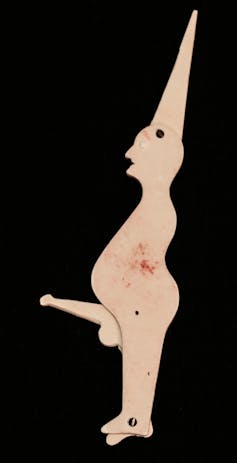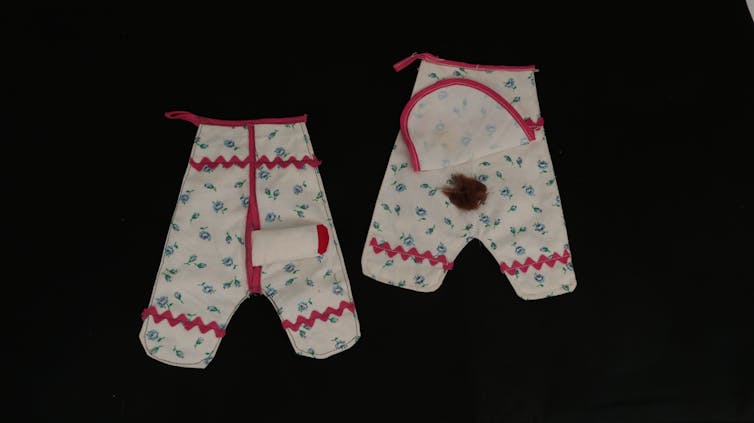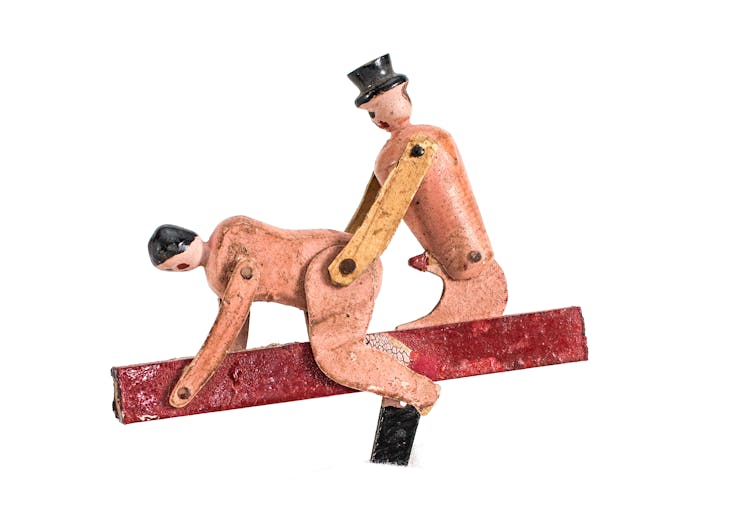America's hidden world of handmade pornography
One scholar spent a decade studying the ways everyday people drew, carved, glued, sewed and baked their own pornography.

“To live among the handmade,” philosopher and antiques dealer Leon Rosenstein once said, “is to live among the human.”
Well, there’s nothing more human than handmade pornography.
When you hear “pornography,” you might think of Playboy and Penthouse, X-rated movies and internet porn.
But one type that has been largely hidden and forgotten is the pornography people make for themselves. Unlike pornography for profit, handmade pornography is crude and funny and subtle. It, too, contains multitudes.
Over the past decade, I’ve visited archives and museums, met with collectors and antiques dealers, and talked with artists and scholars to reconstruct the ways people across America, from the 1830s to the 1970s, drew, painted, glued, sewed and baked their own pornography. Some altered coins or carved objects from wood, stone and bone. Others wrote stories, made pamphlets and designed comic books.
Despite the concerted efforts of law enforcement and social purists to destroy sexual artifacts, thousands of these fascinating objects remain. And now I’m publishing the first history of homemade and handmade pornography.
I’ve titled the book “The People’s Porn” because the objects being considered come from a true representation of the American people. As opposed to commercially produced pornography imported first from Europe to early America and then pirated as bootleg editions in major cities, these materials, often made with rudimentary artistic skills, cropped up organically in communities, small and large, across the country.
From funerals to farms
Pornography went wherever Americans went – in life and in death, at war and at sea. Men carved wooden pornographic objects at logging camps in the 19th century, and they made pornographic scrimshaw on whaling vessels during the 18th and 19th centuries. Others were inspired to refashion the 19th-century liberty penny that had “ONE CENT” written on the reverse side of the coin. By changing the “E” to a “U,” many Americans had the same idea for rendering the coin obscene. Who knows how many pockets jingled with these pennies over the years?

In many handmade objects, sexual gestures stand right behind propriety and erections pop up in staid places. For example, in the late 19th and and early 20th centuries, people made small, carved coffins as a form of memento mori that concealed carved figures inside. When you lift a coffin lid, the male figure’s erection pops up. The popular objects were hand-carved, hailing from places that still prepared their own dead for burial and still made coffins for neighbors and kinfolk. You can imagine them circulating discreetly at wakes and memorials, provoking laughter even as people mourned.
Pornographic objects also leered about the barnyard, a reminder that America was a largely rural country up until the 1920s. When pornography showed cocks mounting hens, dogs humping each other and pigs acting like swine, it demonstrated that animals remained underfoot and in people’s sexual imaginations.
And when called to war, men made pornographic objects out of spent shells and casings and adorned planes with their favorite nudes.
Postwar pornographic potpourri
Despite the postwar world’s reputation for cultural conservatism, pornographic objects continued to be made in the home.
Women circulated patterns for pornographic potholders and aprons. Made with a wide variety of fabrics and trimmings, potholders came in pairs, with one side featuring a pop out penis and the other a vulva. Cookies, aprons, hook rugs, embroidery – all traditional women’s crafts – also came in pornographic form. Joined by explicitly feminist materials in the 1960s and 1970s, women’s creations show that the category of pornography can be much more capacious than you might think.

People from all walks of life – young and old, gay and straight, rich and poor, Black and white – made objects that the established order found embarrassing and preferred to ignore. Using commonly available materials, they found a way to express what moved them, what frightened them, what aroused them and what made them laugh.
Even as consumer culture expanded, pornography continued to be made by hand as people sought to articulate their own visions of sexuality. The mass market eventually took notice of these do-it-yourself productions, whether pornographic or not. By the 1990s, “amateur porn” started to flood the market in response to cravings for authenticity.
But you shouldn’t confuse this category of commercialized porn with what people made and continue to make. Handmade and homemade materials can expand our understanding of sexuality. Sometimes it’s beautiful. Sometimes it’s ugly.
As much as the world might like to limit sexuality to the realms of the uplifting and transcendent, homemade pornography – in all its incoherent, libidinal, confusing strangeness – reminds us that we are imperfect in body and in mind, subject to pain as well as pleasure, willing to laugh at ourselves and each other, and moved equally by the ridiculous, the violent and the sublime.

[Deep knowledge, daily. Sign up for The Conversation’s newsletter.]
Lisa Z. Sigel does not work for, consult, own shares in or receive funding from any company or organisation that would benefit from this article, and has disclosed no relevant affiliations beyond their academic appointment.
Read These Next
Why are some Black conservatives drawn to Nick Fuentes?
Black Americans and white nationalists have joined forces in the past. And a number of cultural and…
I study rat nests − here’s why rodents make great archivists
An archaeologist reveals what she learned from sifting through a 200-year-old rat nest recovered from…
As millions of Americans face a steep rise in health insurance costs, lawmakers continue a century-l
US health care policy will remain fractured until lawmakers address the core question of who is responsible…






